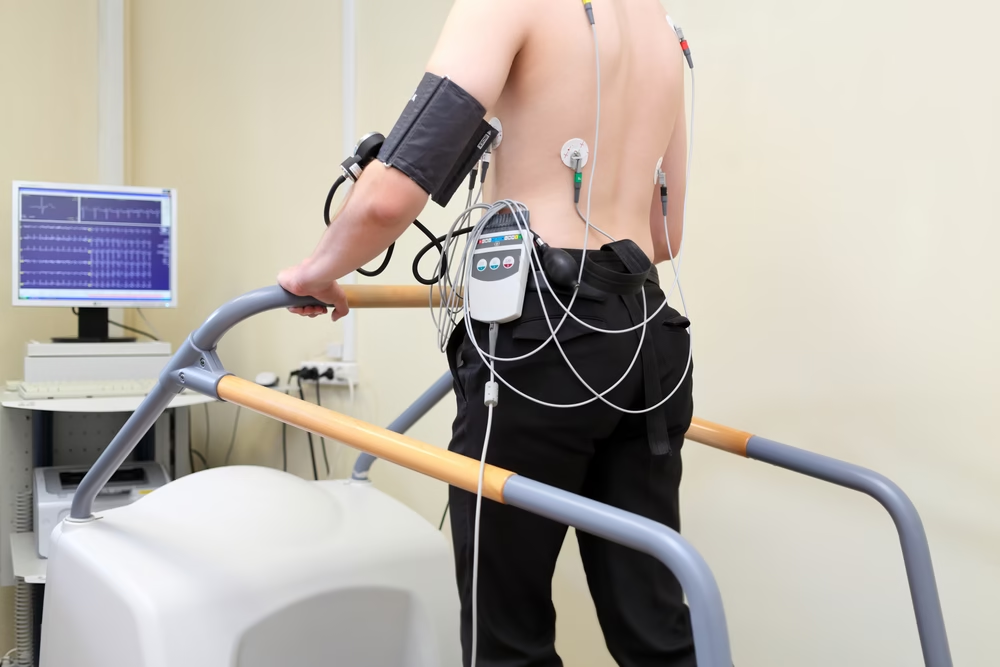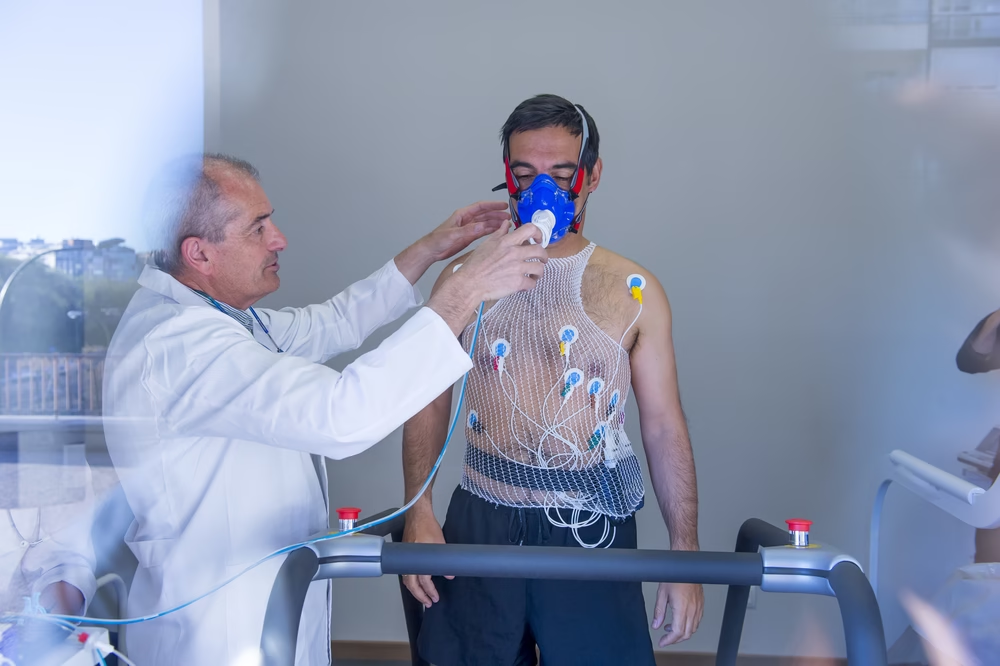1 in 4 deaths in India is caused by heart disease.
What most people don’t realize is that almost half of all heart attacks occur without any previously recognized warning signs. You won’t always get chest pain. You won’t always collapse. Sometimes, your heart simply … slows down, quietly. And this is where the Treadmill Test (TMT) comes in—not as a gym machine, but as a diagnostic lifeline. At SAAOL Heartcare Delhi (a brainchild of Dr. Bimal Chhajer), we believe in non-invasive heart treatment. Tests like TMT and treatment like EECP are helping thousands avoid bypass surgery and reverse heart disease without surgery, before it turns into something irreversible.
Let’s be honest for a moment:
If your heart were going to fail next year, how would you know today?
No smart watch alarm. No chest-gripping moment. Only a sense of “I’m tired” or “I’m aging” or “Maybe I’m simply out of shape.” And that’s where the Treadmill Test, i.e., TMT, comes in. It’s not just a test. It’s a glimpse into how your heart performs under pressure. Not when you’re relaxed. Not when you’re lying still. But when your body craves more, and your heart struggles to keep up.
Table of Contents
ToggleWhat is a Treadmill Test?
In non-technical language, a Treadmill Test (TMT) or Cardiac Stress Test is a controlled test where you walk on a treadmill while being connected to the ECG leads. While the speed and grade on the treadmill increase gradually, physicians will monitor how your heart rate and rhythm, as well as your blood pressure, respond to exertion.
But here’s the interesting part:
You’re not doing this to prove your stamina.
You’re doing this because heart diseases often hide until your heart is under stress.
Your ECG at rest may be completely normal. But during exercise? That’s when the red flags fly.
What the TMT Shows (Or Doesn’t Tell You)
Let’s pull back the curtain. Many feel TMT is no more than simply trying to detect if anyone with blocked arteries. That’s just 10% of the picture. The full story?
Neurocardiac Reflexes
TMT measures the connection between your heart and your nervous system. Do they synchronize under stress? Or does your heart race and beat irregularly?
Cardiac Reserve
Think of it as the heart’s “fuel tank.” TMT reveals how much higher your heart can safely stretch itself before it starts to struggle. Diminished cardiac reserve is a strong predictor of cardiac events long before symptoms start.
Silent Ischemia
This is a biggie. Many people, including some diabetics, have heart disease without pain or symptoms. TMT exposes this “silent starvation” of the heart muscles by revealing electrical changes in the ECG.
Chronotropic Incompetence
Sounds fancy. It’s just: Can your heart speed up when you need it? If it cannot, there may be substantial underlying autonomic problems, a hidden cause of fatigue and breathlessness, even among those under 40.
Who Should Consider a Treadmill Test (TMT)?
Here’s the shocker: Even if you don’t have chest pain, you might still need a TMT.
Here’s a checklist of who should seriously consider it:
- You’re a man over 35, and you have a sedentary lifestyle
- You’re planning to start a new fitness routine
- You have diabetes or hypertension
- You are a smoker (or a former one)
- You have a family history of heart disease
- You’ve ever had unexplained exhaustion, dizziness, or shortness of breath
- Your cholesterol numbers look weird, but doctors say, “Let’s wait and watch.
You can easily find such patients at SAAOL Heartcare Delhi, who are in the age range of 35-55, who believe they are okay, just because they run a couple of times a week and might play cricket over the weekend. But one TMT showed how close their heart was to breaking in a way they never would have seen coming.
What Happens During the Test?

Now, let’s get the anxiety out of the way — it’s not scary, it’s not painful, and it’s monitored from beginning to end.
Here’s the sequence:
- You are hooked up to ECG electrodes (don’t worry, you’re just wearing stickers on your chest).
- You walk on a treadmill — first flat, then gradually steeper and faster.
- The test lasts about 6-12 minutes (or until you reach your target heart rate).
- You’re monitored the entire time with ECG, heart rate, BP, and symptoms in real time.
You can stop any time. It’s not a willpower test, it’s a window into how your heart reacts when pushed.
When a ‘Negative TMT’ Still Doesn’t Mean You’re Safe
A negative TMT ( no evidence of blockages) isn’t an assurance that you don’t have heart disease. All they’re saying is that the current level of activity isn’t demanding any more blood supply to the heart than what it’s already getting.
But:
- Small blockages can still grow.
- Plaque can still rupture.
- Inflammatory markers might be rising silently.
Which is why Dr. Bimal Chhajer recommends a total preventive program — not just testing, but lifestyle reversal via diet, EECP treatment, yoga, and non-surgical heart disease treatments launched at SAAOL Heartcare Delhi.
What If Your Treadmill Test (TMT) Is Positive?

Testing positive may sound terrifying, but in reality, it is a blessing in disguise.
Well, because you caught it as the damage was still reversible. Even if your TMT shows ischemia or arrhythmias, it doesn’t mean you need surgery. That’s where non-surgical alternatives to bypass surgery come in:
- EECP treatment in Delhi/NCR, a natural bypass without cuts or stents
- Dietary reversal therapies (a core part of the SAAOL program)
- Stress management, yoga, and detox therapy
Thousands have followed this path to avoid bypass surgery, and live heart-healthy lives… without stents and the scars of open-chest surgery.
How TMT Can Rescue Millennials as Well
Heart attacks in India are hitting people as young as 25–30. And most of them? No prior symptoms. No prior check-ups. This is why SAAOL is now recommending TMT even for asymptomatic young professionals with high stress, irregular sleep, or poor eating habits.
You don’t have to wait till something breaks to fix it.
The Real Takeaway: TMT is a Prevention Weapon
A TMT is not designed to frighten you. The intention behind it is to wake you up, gently.
It responds to three crucial questions:
- Is your heart beating right?
- Is there any stress that never goes away?
- Are you walking toward a heart crisis—or away from one?
At SAAOL Heartcare Delhi, Heart disease reversal is our goal, not merely diagnosis.
With non-invasive heart treatment, EECP, and a holistic lifestyle program by Dr. Bimal Chhajer, we aid millions of people to reclaim their heart health naturally as well as scientifically.
Conclusion
If you’re still reading this, chances are—you needed this.
Maybe for yourself. Maybe for someone you love. Perhaps because you’ve had it with pills, panic, and partial truths.
So here’s your next step:
Get a TMT. Understand where you stand. And from there, seize control — not fear, but power. You’re not broken. You’re just early. And that is the perfect place to be.
Want to speak with someone who knows your heart better than anyone else?
Contact SAAOL Heartcare Delhi. Your heart does not just beat here. It heals.


